Some of the links in this post may be affiliate links.
This is the ultimate, most comprehensive rubber plant care guide you will find! I’ve spent a lot of time documenting my own experiences and also surveyed my large Instagram audience to expose the most common problems with this plant and how to solve them!
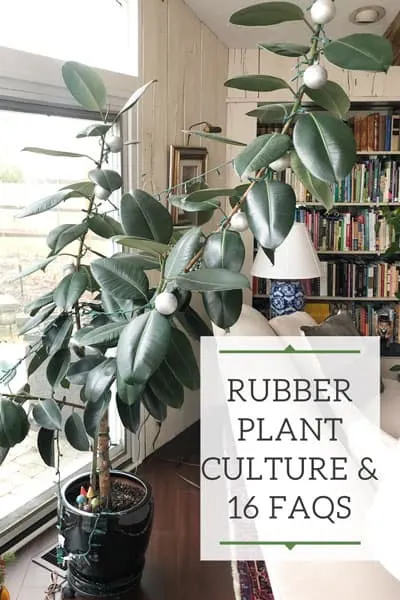
It is my goal to help your rubber plant thrive. If you are having problems and your plant is dying, I’ll help you reverse it and get back on track.
Whatever your rubber plant problems or woes are, you will find it here. But before I get to each specific problem, I urge you to take the time to read through the entire post in the order that I’ve written it.
Plant care is about getting a combination of things right, and not just one aspect. Only then will you have a thriving houseplant.
I have included general care information for all varieties of rubber plant (Ficus elastica) and if there is anything different about the care or problems of each variety, I have called it out.
The most common rubber plants that will find on the market include:
F. elastica ‘Decora’ is probably the most common and typical variety
F. elastica ‘Robusta’ has larger leaves than ‘Decora’
F. elastica ‘Burgundy’ has very dark leaves with a reddish midrib
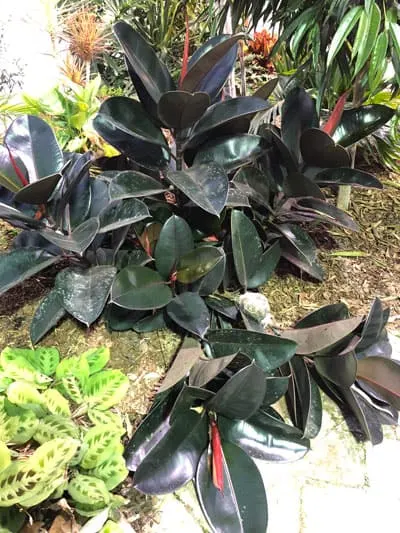
F. elastica ‘Tineke’ has gorgeous yellow and shades of green variegation
F. elastica ‘Ruby’ has stunning pink variegation
Table of Contents
Rubber Plant Care
Below you will find everything about the care of Ficus elastica. This species is native to south Asia and is a type of fig. It is related to the fig that you eat. They are both in the Ficus genus.
Light
Let me set something straight. One of my pet peeves are plant labels and many growers label these plants as low light plants.
I’d like to clarify once and for all, that this is incorrect. Many people unfortunately take this “low light” label to mean that the plant requires low light. The plant owner then proceeds to shove the plant in a dark corner.
This is not what this plant needs! I have my own plant growing in front of a very large Eastern exposure window. It is as close to the window as possible without touching it. My plant enjoys morning sun and it is thriving.
North windows would be acceptable, but the plant needs to be as close to the window without touching it. Light intensity drops dramatically with each foot that you move away from a window.
If you have a super sunny window, such as a large Western exposure or Southern exposure window, you can maybe have your plant set back a little, but not too far.
And of course there are many factors that affect the amount of light: the size of the window, any obstructions outside that could be blocking light, and many other factors.
Whatever you do, realize that in most cases, keeping your plant several feet or further away from most windows is not acceptable. Your plant will languish and I will describe the various problems that can occur at the end of this post.
I have done quite a bit of traveling around the world and have seen rubber trees growing in the ground in many warm climates. They are large trees in nature and grow in full sun, or close to full sun.
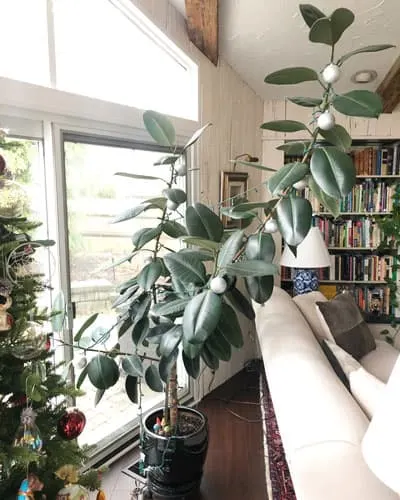
One word of caution, if you have had your plant growing in really low light, don’t just place your rubber plant immediately into a lot of direct sunshine. Your plant needs to harden off first and slowly acclimate to more light.
I describe the hardening off process in a blog post that I’ve written. This is is ESPECIALLY important if you ever place any of your houseplants outside during warm months.
Temperature
These are warm growing plants so try and maintain indoor temperatures at a minimum of about 60F.
Try to avoid locations where these plants might get direct, very cold drafts. Ficus do not like this!
Water
This is a very important aspect of rubber plant care. It is important to water these plants thoroughly, but they need to dry out a bit in between.
Do not allow water to sit at the bottom of the pot for extended periods. Any Ficus hates this and you will run into issues if you do.
At the same time, you can quickly cause a lot of damage to your plant if you let all of the soil completely dry out for extended periods of time. I’ll describe all these problems at the end of the post.
Aim to let approximately the top quarter of the potting mix to dry out. Keep in mind that smaller pots, especially terra cotta pots, will dry out much more quickly than larger pots.
So it is important to monitor the soil moisture by feeling the potting mix. Do not rely on soil moisture meters because these can present a lot of problems.
Fertilizing
Throughout the growing season, except in the pits of winter when almost nothing is growing, I like to use Dyna-Gro Grow fertilizer on my rubber plant which I get on Amazon.
I prefer to fertilize with every watering throughout the growing season. I simply add 1/4 teaspoon to a gallon of water and fertilize every time I water.
Dyna-Gro Grow is an amazing, complete fertilizer that is urea-free and contains all micro and macro nutrients. It is a one-stop shop of fertilizers and you can use this for all your tropical foliage plants.
Soil Mix
Proper soil mix is absolutely critical for any Ficus. They demand very sharp drainage. When I water my own plant, the water doesn’t sit on the surface at all. It immediately is absorbed and drains very quickly.
How did I accomplish this?
I used a blend of an all-purpose potting mix, such as Miracle-Gro, and added plenty of perlite and also orchid bark mix that I have on hand from all the Phalaenopsis orchids that I grow.
I don’t always measure the ratios exactly, but plan on about 60% potting soil, 20% perlite and 20% bark mix. This reduces to about 3 parts potting mix, 1 part perlite and 1 part bark mix.
My rubber plant thrives and love this mix!
An excellent super-well draining potting mix and watering practices are very critical for any Ficus, including the very finicky Fiddle Leaf Fig, or Ficus lyrata.
If you want some amazing turn-key mixes to use straight out of the bag, check out my post on best soil for rubber plants.
Pot Size
When repotting your plant, a good rule of thumb is to only go up one pot size. If your plant was in a 4 inch pot, repot into a 6 inch pot.
I’m not saying that you absolutely can’t repot into a pot that is 2 sizes bigger, but it will greatly increase the risk of issues, especially if your growing conditions are not ideal.
Potting your plant into a pot that is much too big for its root system greately increases the risk of the soil staying wet for a longer period of time because you have a lot more soil. Ficus in particular hate this and will protest.
And if you compound this with keeping your plant in a dark location, the soil will stay wet for even longer. This is one example of why I mentioned earlier that in order for your houseplants to thrive, you must have all the important elements in balance: light, watering, potting mix, etc.
Cleaning Your Air
Did you know that the rubber plant is a fantastic plant to clean your indoor air? It is especially effective at removing formaldehyde from indoor air! This was one of many plants that NASA did a study on, so it is a very beneficial plant to have indoors.
Check out my blog post on the 9 easiest plants to clean your indoor air.
Not only does this plant clean your air, but it also transpires a lot of water so it helps to humidify your indoor air as well! If you’re interested in this topic, check out my blog post on 50 houseplants that humidify your indoor air.
Cleaning the Leaves
There are a few ways to clean the leaves on your Rubber plant and it’s easy to clean rubber plant leaves one by one because they’re so big.
Wipe with Damp Cloth
If your rubber plant leaves are just lightly dusty, simply take a damp sponge, cloth, or paper towel and gently wipe the surface of the leaves.
Rubber plant leaves can collect a LOT of dust so it is important to keep them clean so the can photosynthesize better, and this also helps deter pests!
Wipe with Soap/Water Mixture
If your leaves are pretty dirty and you want to get a better cleaning, add a little dish soap to warm water. You don’t need much. Just a couple drops on a wet sponge, or mix up some soapy water in a container.
Gently wipe the leaves with the mixture to remove any dirty or heavy dust buildup. When you are done, be sure to rinse the plant off with plain water water to remove any residue, or wipe the leaves off with plain warm water
Do Not Use Leaf Shine Sprays!
First of all, it will give them a very unnatural look. But most importantly, the leaf shine sprays will clog the stomata (or leaf pores) that plants essentially use to “breathe.” Avoid these sprays!
Propagation
The best way to propagate rubber plants, and the one that shocks the cuttings less than any other method, is by using a process called air layering.
With air layering, you are actually rooting a new plant while it is still attached to the mother plant. Once it is rooted, you simply cut it off and plant it in its own pot.
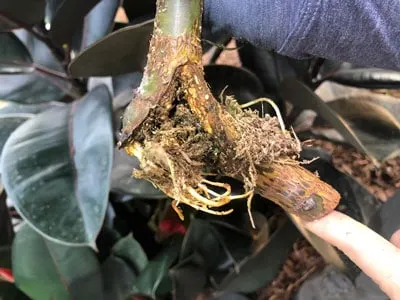
Check out my blog post on how to air layer rubber plants for a step by step method.
Air layer is also the best method, if not the only good method, to root a woody stem.
For a much easier approach, check out my post on how to propagate rubber plants in water.
Pests
Spider Mites
Spider mites, if allowed to go out of control, can be a very serious problem and difficult to control. If you have spider mites, you will see very fine webbing on the leaves an stems, especially where the leaves meet the stem.
You will also see some discoloration and uneven coloring on the leaves.
Early detection and action is key. Check out my spider mite blog post to learn how to safely and naturally treat spider mites, and how to discourage them from coming back.
Scale
Another common pest that you may occasionally see is scale. Scale appears as small, round, brownish, hard shells that attach to the leaves and stems.
Be sure to closely inspect your entire plant carefully, including the undersides of the leaves, stems and any hidden areas.
Remove each scale with your fingers, and then dab that area with rubbing alcohol. Simply dip a cotton ball or paper towel in rubbing alcohol and apply to the area where you removed the scale.
Don’t do this on the entire plant. Just the affected areas. After you treat the plant, keep a close eye on the plant to ensure that it doesn’t reappear. Continue to treat as needed.
In between treatments, you may also want to spray off your rubber plant with water in the shower, or in the sink if you have a small plant, to help clean and wash off your plant.
With pest management and pest prevention, keeping a close eye on your plants is key for success.
Sheath
At the tip of each stem, you’ll notice that the growing tip has a covering called a sheath. Some people mistaken this for a flower, but it is simply a protective covering that each new leaf has when it grows.
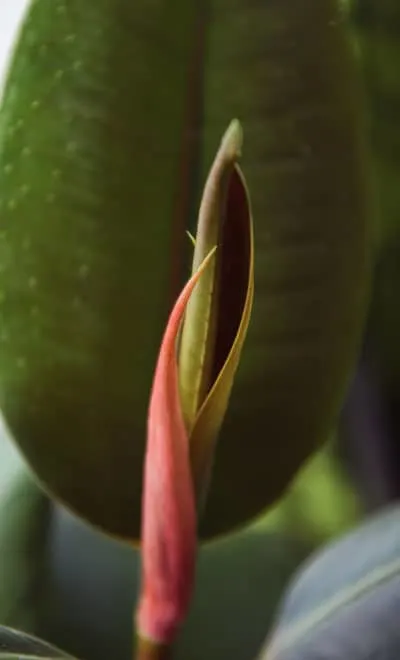
The sheath will eventually loosen and fall off as the new leaf gets bigger.
Toxicity
Ficus elastica is mildly toxic to cats, dogs and humans. When you prune the plant of break a leaf off, you’ll notice a white, milky sap oozing out.
If you come in contact with this, be sure to wash your hands off immediately.
If eaten by cats or dogs, it can cause gastrointestinal issues.
Frequently Asked Questions
I’ve been asked the following questions from my followers on Instagram (my profile is @ohiotropics). And there are a lot of questions!
1. How can I get it to branch out from only one stalk?
You have two options to get a plant that branches out. First, you can just purchase it that way (instant gratification). Or if you have a single stalked rubber plant, you will have to chop the top off right above one of the leaves.
Soon, you should hopefully see at least a couple new stems forming. If you have a woody rubber plant, you may want to air layer your rubber plant. This way you can propagate your plant at the same time!
Check out my blog post on how to make a rubber plant bushy by pruning.
Lastly, there is another method called notching, where you don’t actually cut anything off the plant. You simply make selective partial cuts on a branch, right above a node, and this can trigger side branches to form.
I don’t have a blog post yet on this topic, but stay tuned…
2. Why is my rubber plant not growing?
In the vast majority of cases, it is one simple answer: light. If your rubber plant is not sitting right in front of a window, I want you to move it there right now and wait. Be patient.
Of course you’ll need to follow good cultural practices for watering as well.
In most cases when people message me on Instagram (@ohiotropics) that their rubber plant is not growing, I always ask for a photo showing the growing location of the plant.
Most of the time it is sitting in a dark corner. There are no shortcuts for plant growth. Light is the most important factor and you can’t expect your rubber plant to thrive and grow well if it is shoved in a dark corner somewhere in your home.
3. Why do my leaves fall off, still green, until the entire branch is defoliated?
There can be various causes of this. One may be a sudden decrease in light. Did you just buy your plant from a nursery and you just brought it home?
Often times, rubber plants may have an initial protest by dropping some leaves initially until it gets used to its new environment. Light is paramount though so I can’t emphasize enough that your rubber plant needs to be right in front of a window.
4. Why are the new leaves smaller than the older ones?
To me, this signals that the growing conditions were not as good when your rubber plant grew the smaller leaves. This is probably due to not enough light. Move your plant to an area with brighter light (you guessed it…in front of a window).
5. How do I keep my Ruby leaves pink?
If your Ficus elastica ‘Ruby’ leaves are not as pink, you probably need to increase the light levels. For best results, your Ruby needs to be right in front of a window to bring out the best color in the leaves.
This is a balance though because too much direct sun on the variegated varieties can scorch the leaves as they are a bit more sensitive than non-variegated versions. I should add that the scorching is mostly an issue if you are increasing the light too abruptly. Variegated rubber plants can take plenty of sun and I’ve seen them grow in full sun outdoors.
So anytime you are moving a plant into much brighter light/sun, make sure to do it slowly to avoid scorching.
Growing these plants indoors, Eastern exposure windows should work well in most cases, or even Western or Southern windows. Rubber plants grow in full sun outside, so there is no reason you can’t give your plant as much sun as it can get indoors, where light intensity is much less than outdoors.
6. Why are some of my leaves folding like a taco?
This is most likely a watering issue. Take a look at the plant below. This was a friend that reached out asking what was wrong. She was using a moisture meter and hadn’t watered her plant in months. Months!
The moisture meter told her she was ok, but after a few months, the soil was bone dry for a long time and the resulting leaves were wrinkled, folded and taco-like.
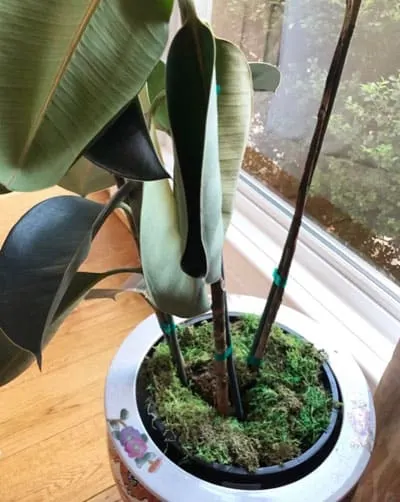
Read about the dangers of using moisture meters for plants.
7. Why do my leaves get discolored, then turned yellowish, and then turn brown and fall off?
This is normally caused by improper watering. Either the soil has been left too dry for too long (“underwatering”) or the soil has stayed too wet for too long (“overwatering”).
When you first notice yellow leaves, immediately check the soil with your fingers and lift the pot if you can to check the weight.
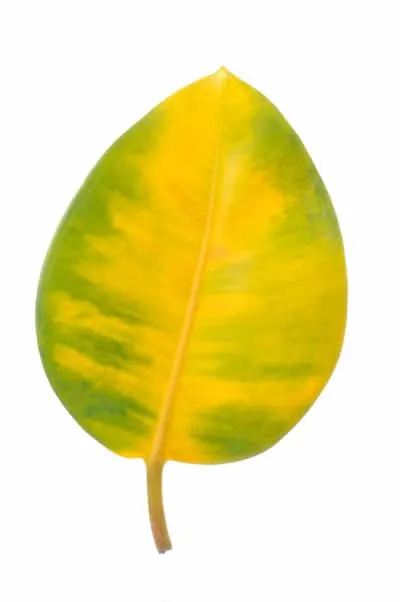
Is the soil completely dry and perhaps it has stayed dry for too long? Does the pot feel very light? Or is it sopping wet and perhaps has stayed that way for a while? Both of these conditions can cause yellowing leaves.
You need to strike a balance with watering. Re-read the watering section earlier in this blog post and try to follow all the other cultural practices with light, fertilizing, etc.
It could also be that your rubber plant is severely pot bound and needs to be repotted into a bigger pot. Be sure to read these critical repotting tips before you repot any houseplant.
8. Why are the lower leaves turning black and falling off?
This is normally due to improper watering. Read the answer to the question above.
9. Why are there brown spots on the leaves?
This could potentially be the result of a bacterial or fungal infection. Bacterial infections would typically have a yellowish halo around the brown spot, and fungal infections would typically lack the halo.
These infections can be caused by keeping plants too wet, especially in areas of low light and poor air circulation.
10. Why do my leaves have tiny white spots?
If you see little tiny white dots around the outer edge of your rubber plant leaves, this is no cause for alarm!
These tiny white dots are called lithocysts. Lithocysts are enlarged cells that contain calcium carbonate crystals and is normal for rubber plants. I don’t know what their purpose is, but just know that it is normal!
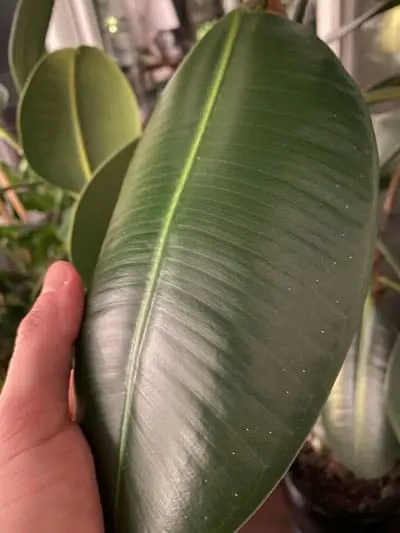
11. Why are my leaves curling up and drooping?
This is most likely due to a watering issue. Keeping the soil too dry or too wet can cause the leaves to droop and curl.
As soon as you notice your leaves curling and/or drooping, feel the soil of your plant. Is it super dry? Is it wet? This will tell you what is going on.
If you neglected your plant and it has gone too dry, you need to be more attentive to watering. If your soil is staying too wet for too long, there could be a number of issues that cause this:
- Your pot size might be too big and the soil is not drying out fast enough.
- If your plant is in very poor light, it will stay wet for longer. Move your plant right by a window.
- Has your plant been sitting in excess water in the saucer for a while? This can spell trouble very quickly for rubber plants. Always discard excess water.
- Do you have your plant in a pot without a drainage hole? This is a no-no. Immediately transplant your rubber plant into a pot with a drainage hole. Ficus are very sensitive to sitting in water.
- Maybe everything else checks out above, but your plant is sitting in a cool/cold room. Move it to a warmer location. These plants don’t like cold conditions and they hate drafts.
Curling can also be caused my lower humidity. If you just have slight curling but the plant looks healthy otherwise, I wouldn’t worry.
Winter is sometimes tough in many areas of the world, but you can increase the humidity with a humidifier if you’d like. Proper watering is by far more important, but if you can increase the humidity as well, this is great for your plants.
12. Why are the new leaves deformed?
Like many things in houseplant care, this can be due to a variety of things from pests, nutrient deficiencies, or inconsistent and/or improper care. All these kinds of stress on the plant can produce deformed leaves.
Check your plant for pests. Do you see anything crawling or flying around? If that checks out OK, think about your care. Have you ignored your houseplant for a while? Maybe let it stay dry for a very long time while new leaves were developing? And maybe it is also in a dark spot?
Inconsistent care can result in deformed new leaves. Resume consistent watering, light levels, etc and your plant will thank you and new growth will look normal again.
Nutrient deficiencies are not as common, but if you are using a good, complete fertilizer (available on Amazon) like Dyna-Gro Grow, you should not have to worry about these issues. And you should be fertilizing regardless!
13. Why are there brown edges on the variegated rubber plants like tineke and ruby?
This is either due to inconsistent watering, or sun scorch from not acclimating your plant to brighter light properly. Variegated rubber plants can easily take a lot of direct sun. If your plant previously has been in a darker spot, acclimate your plant slowly to any direct sun to avoid any issues.
If your plant is growing in very warm or hot conditions, and it is receiving direct sun without acclimation, it may scorch the leaves. Variegated plants are sensitive to this.
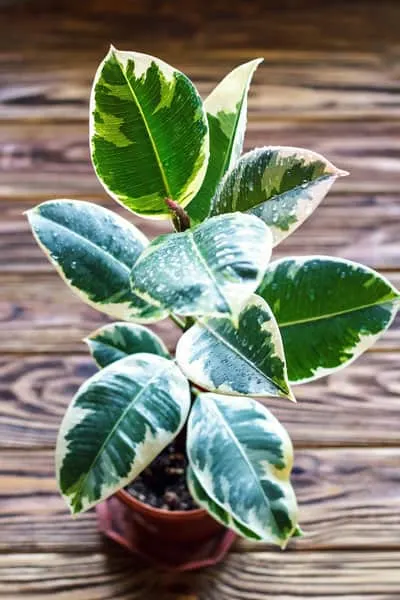
Most often though, any brown areas on your variegated leaves is caused by improper watering, or by extremes in soil moisture overall. Both “underwatering” and “overwatering” can cause this.
You’ll want to give your plant a thorough watering as soon as the top one or two inches of the pot (depending on the size of the pot) is dry. Discard excess water.
14. How can I get hard water stains to come off the leaves?
You can safely and easily remove those stubborn hard water stains from your rubber plant leaves. Simply mix 1 teaspoon of white vinegar to a gallon of warm water.
Gently wipe the leaves that have hard water stains. The vinegar helps to dissolve those stubborn mineral deposits from hard tap water.
This method should be used sparingly and only when absolutely needed.
15. Why did my rubber plant drop leaves when I first brought it home?
When you first bring a plant home, some plants may respond a little dramatically by shedding leaves. The plant can be in shock from having gone to a bright, humid greenhouse to average indoor conditions.
Be sure to place your plant right in front of a window (ALL the time, but especially when you first bring a plant home) in order to make the transition a little smoother.
16. Why is my plant staying bushy but not growing tall?
If your rubber plant is staying in it’s bushy form and not growing at all, you guessed it…it probably needs more light. If you just moved your plant into brighter conditions, give it a little time. Proper watering, light and fertilizing will eventually get you there, but have a little patience.
As you’ve discovered, there can be a LOT of problems with rubber plants. But they truly are easy if you follow my cultural practices concerning light, watering, and soil. It is one of my easiest least fussy plants.
Once you understand your plants, care will become second nature! If you’ve enjoyed this post, be sure not to miss my post on beautiful rubber plant varieties.

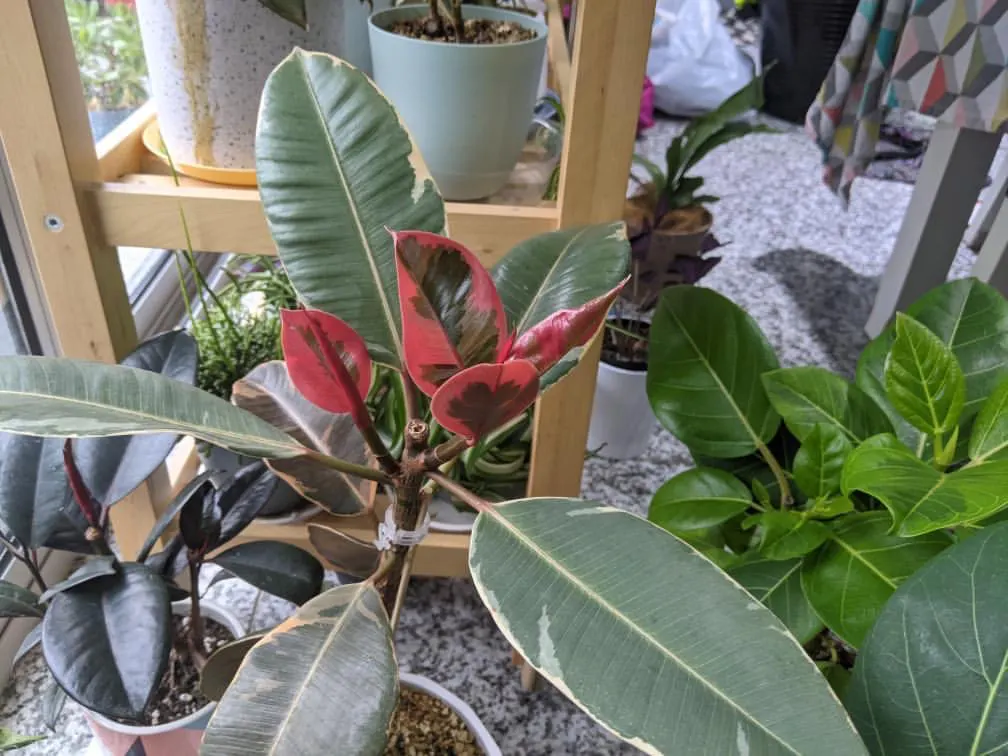
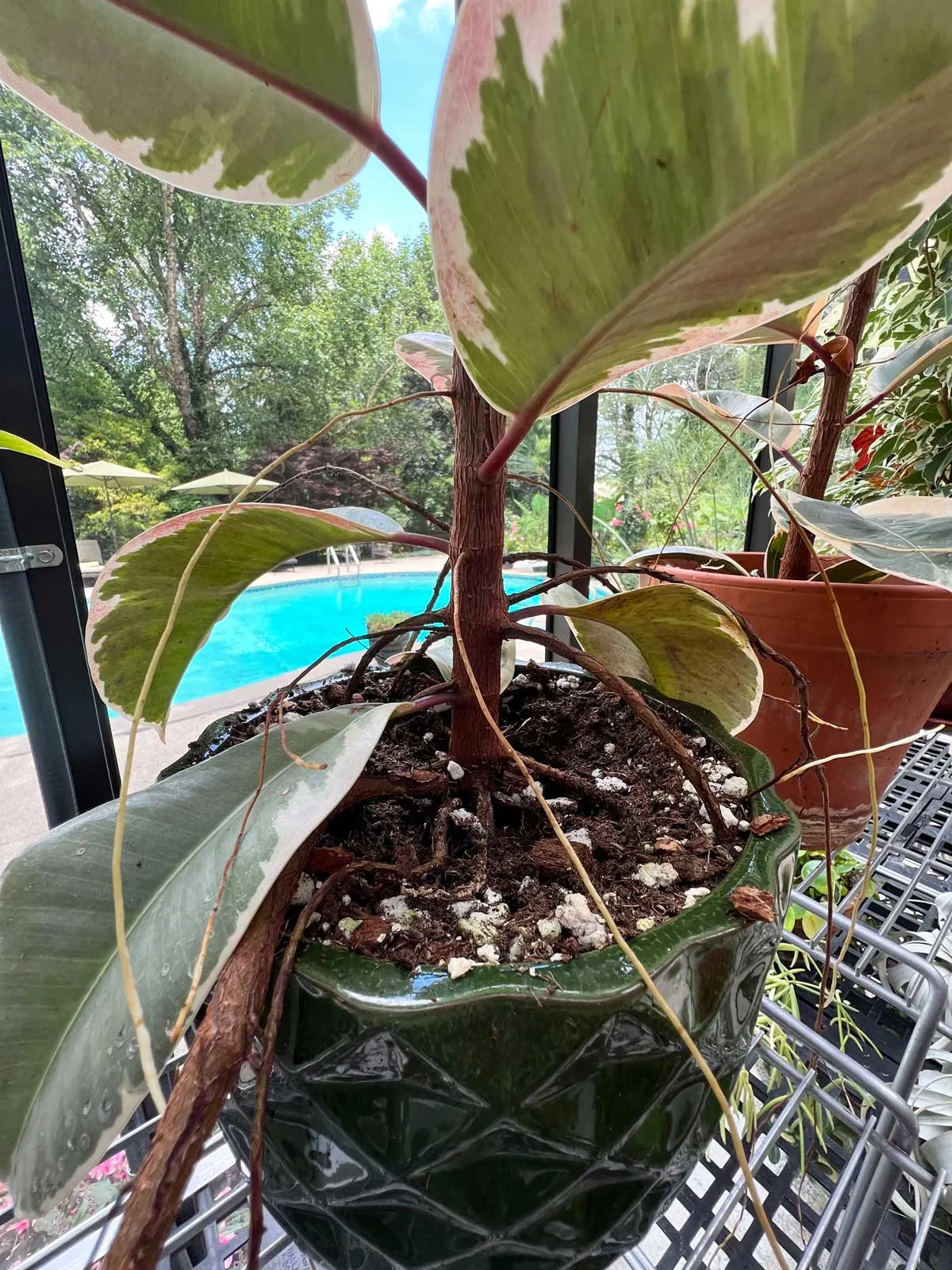
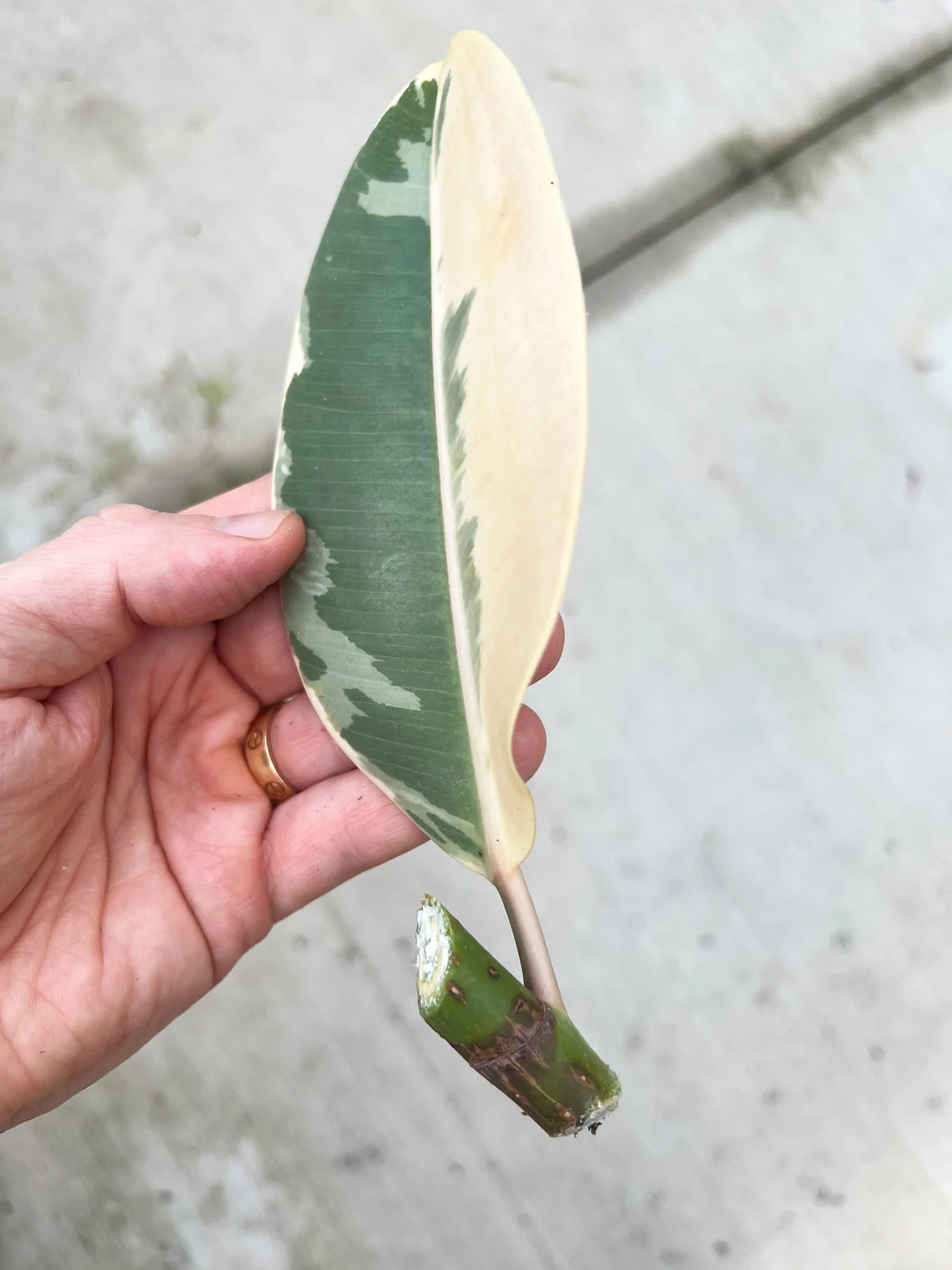
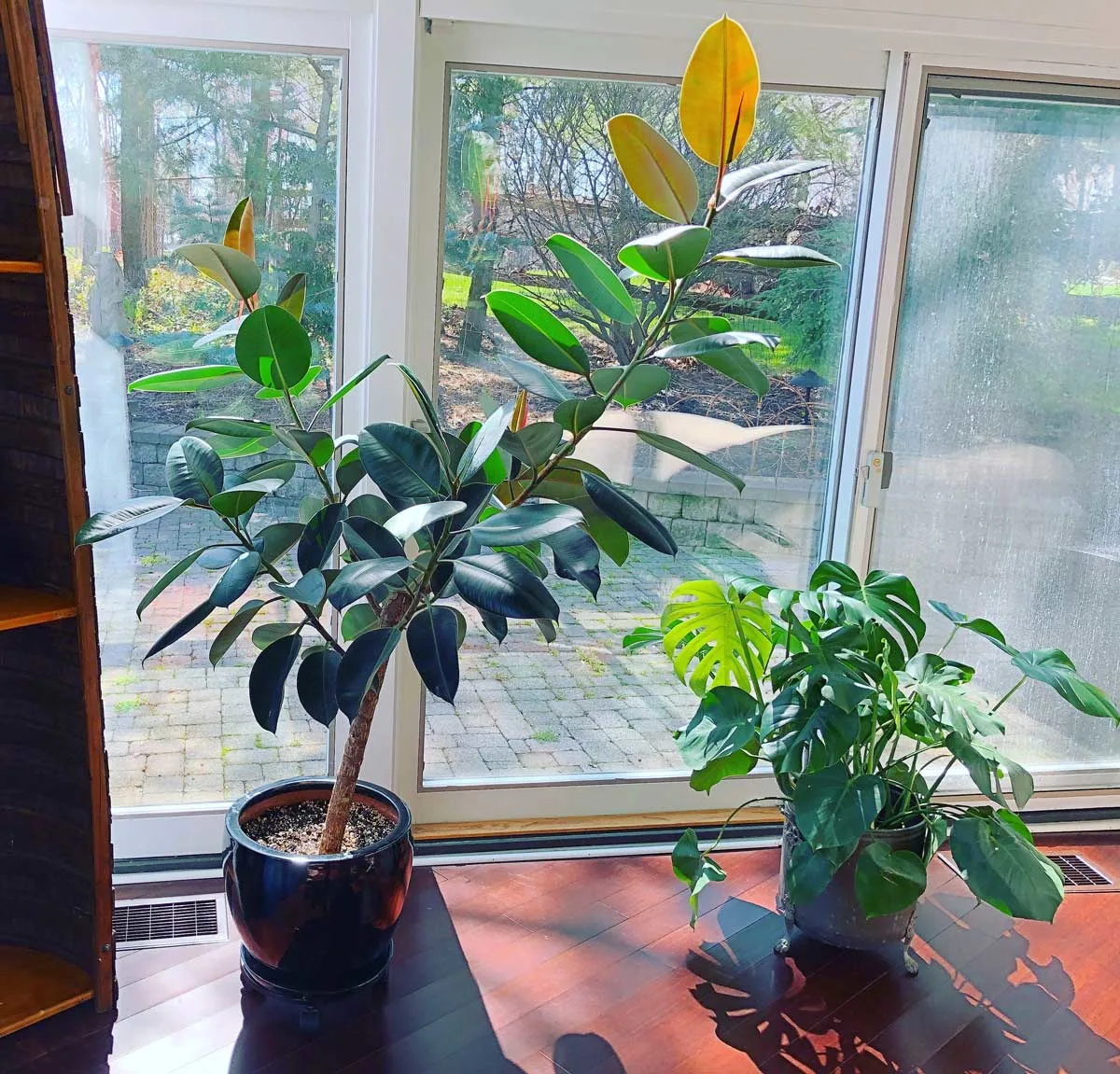
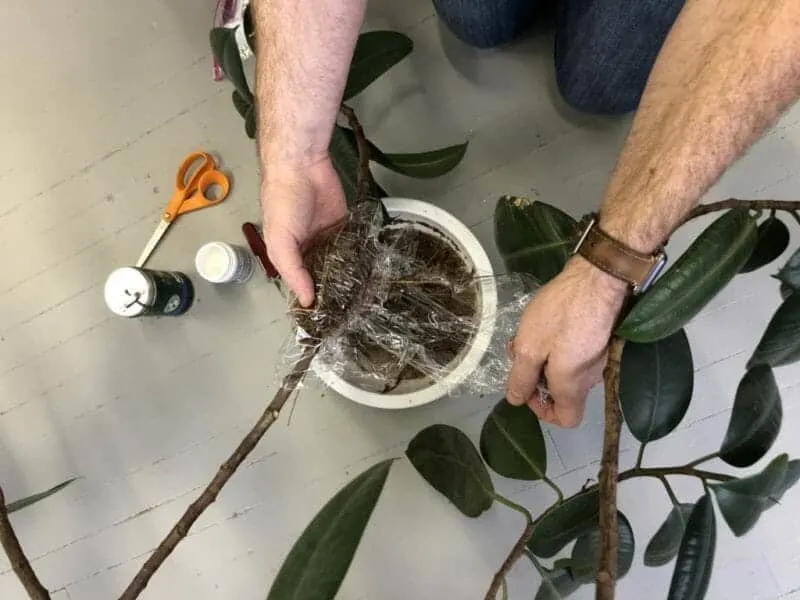
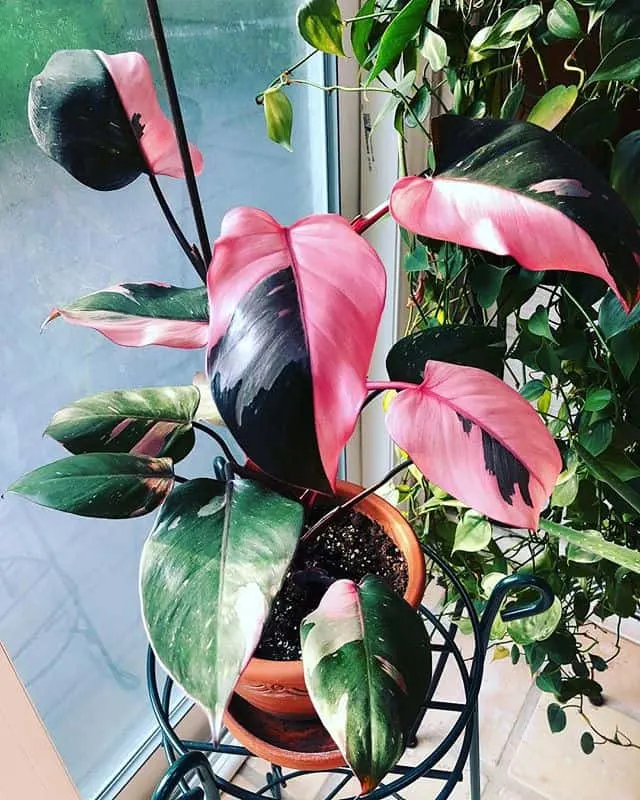
Michelle
Thursday 21st of March 2024
Thank you for taking time on share this.
I hope you could help on my short rubber plant. I bought it a month ago, found some pests on it and I managed to fix them except for the growing leaf coz it’s already dead. I plucked it and wiped the stem with hydrogen peroxide but it’s still not growing. The plant still looks healthy but I don’t know how to help it so that a new leaf will start growing.
Raffaele Di Lallo
Thursday 21st of March 2024
Hi Michelle, I would recommend just giving it more time. It can take weeks or longer. Just make sure that you are giving your plant enough light, but you should start to see some new growth in the coming months with good light, good watering practices, etc. Hang in there!
Lindsey Campbell
Monday 9th of October 2023
Hello,
The sheath at the top of my plant turned brown, I left it for a while to see if the leaf would start to unfurl but it too has gone brown and started to die. I am wondering if it's okay to trim the top to encourage new growth? I'm not sure how to attach a picture.
Raffaele
Monday 9th of October 2023
Hi Lindsey! I don't allow photo attachments as a result of page speed issues, but I understand what you are saying. Is your plant pot bound, or has it been kept fairly dry? Sometimes this happens in those cases if the plant isn't getting enough water. What exposure window is it growing in and how far is it from the window? It is definitely ok to trim the plant. In fact, it will make it bushier if you do. I have a blog post on that topic: https://www.ohiotropics.com/2021/09/06/how-to-make-a-rubber-plant-bushy/
Ami
Wednesday 13th of September 2023
Hi there! Thank you for the article!I have a ficus elastica that I rescued, repotted and placed on my porch. Recently we moved and now it's in the backyard and gets afternoon sun and is producing lots of new leaves but the branches aren't able to support themselves and they are sagging down. My burgundy is doing the same thing but gets less sunlight where it's placed. Lots of healthy new leaves but unable to support the weight of the leaves so the branches are falling over. We water twice a week as they are outside in clay pots and it's hot. Is that too much? Please advise. Thank you!
Raffaele
Wednesday 13th of September 2023
It doesn't seem like too much to me at all, especially since it's hot and you have them in clay pots. The drooping sounds like it is simply because of the weight :-) You can always prune your plant maybe at the beginning of spring and it will branch out and get sturdier. The more light you give them, the more sturdy they will grow. Hope this helps a bit!
Gwen
Sunday 30th of July 2023
My 4-foot tall rubber tree is growing new leaves from the trunk for the first time in at least five years. I place the plant outdoors each summer and have not seen this growth before. Coincidentally, my daughter is also experiencing this on her 2-foot tall rubber tree. For her plant, this is the first branching she has seen. Why would this suddenly happen? And to both of us?
Raffaele
Sunday 30th of July 2023
Usually, branching happens most often if you prune your plant, but it will also do it on its own sometimes. It's hard to say!
Dede
Sunday 16th of July 2023
I’ve read conflicting answers to the question, “will a rubber plant regrow leaves on the lower part of the stem?” What is your answer to this question?
Raffaele
Monday 17th of July 2023
Single leaves will not regrow once they have fallen off. However, if you prune the plant, it should grow new branches near where you have pruned. Some people have also tried notching to accomplish this, but I haven't personally tried it.